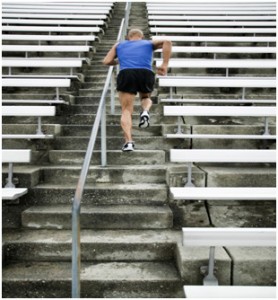 Changes In Stair Design Could Help Fight Obesity
Changes In Stair Design Could Help Fight Obesity
The fight against obesity, according to an article in the June Southern Medical Journal, official journal of the Southern Medical Association. The journal is published by Lippincott Williams & Wilkins, a part of Wolters Kluwer Health, a leading provider of information and business intelligence for students, professionals, and institutions in medicine, nursing, allied health, pharmacy and the pharmaceutical industry.
“Changing stair design to encourage their use requires a set of interventions on both architectural and legislative levels to create physical environments that support active living,” write the authors, led by Dr. Ishak A. Mansi of Louisiana State University Health Sciences Center, Shreveport. His wife, architect Nardine M. Mansi, is one of the co-authors.
Current Design Discourages Staircase Use
Encouraging people to take the stairs instead of the elevator or escalator is a promising approach to increasing moderate physical activity, the Mansis and their co-authors believe. “It involves a lifestyle choice that must be made (people must get to their destination) and it requires no personal financial cost.”
But would climbing the stairs a few times a day really have that much of an impact on overweight and obesity? The authors point out that ordinary day-to-day physical activities contribute the most to total energy expenditure the key factor in maintaining a healthy body weight. Some simple changes in the design and location of staircases could help to make buildings more “physical activity friendly” and contribute to Research suggests that light to moderate physical activity is most effective in motivating people who are currently inactive and obese.
But current approaches to stair design pose a problem. “Stairs are frequently hidden from entrances, with only small signs denoting their locations, typically in connection to the fire exit,” according to the article. Fire exits are usually guarded by heavy doors, not carpeted, and not air-conditioned. Architects find it challenging enough to comply with current building codes emphasizing fire safety and accessibility. “As a result, a conscious focus on health does not enter the design process.”
Suggestions for Improving Stair Design
Some simple interventions can do much toward encouraging people to take the stairs, research suggests. For example, a study performed at a Centers for Disease Control and Prevention building found that playing music in stairwells and displaying motivational signs significantly increased the use of stairs.
These and other measures to make stairs attractive, safe, and readily accessible could help to make buildings more “physical activity-friendly,” the authors write. They suggest several ways to make stairs more comfortable and inviting for example, making staircases wider with less height per step and adding music, lighting, and air-conditioning.
Such efforts would readily fit in with recommended policy and environmental changes to increase physical activity. “State and local agencies are being encouraged by federal and nongovernmental organizations to use policy interventions to address the public health problem of physical activity,” according to the Mansis and their co-authors. They call for physicians, architects, and other professionals to work together to promote change in such policies. They conclude, “Perhaps now is the time to address the need for standard national building codes that incorporate health concerns and support active living.”
About the Southern Medical Journal
The Southern Medical Journal is published monthly by the Southern Medical Association and Lippincott Williams & Wilkins. Devoted solely to continuing education, the Journal publishes annually more than 200 original clinical articles directed to the practicing physician and surgeon on topics such as hypertension, osteoporosis, alcoholism, obesity, dementia, asthma, and diabetes and includes monthly CME features.
About the Southern Medical Association
The Southern Medical Association (SMA) has been serving physicians’ needs since its inception in 1906. SMA’s mission is to promote the health of patients through advocacy, leadership, education, and service. Mark your calendars to attend the Annual Scientific Assembly of Southern Medical Association, December 3-5, 2009 at the Gaylord Texan Resort and Convention Center in Dallas, Texas.
About Lippincott Williams & Wilkins
Lippincott Williams & Wilkins (LWW) is a leading international publisher for healthcare professionals and students with nearly 300 periodicals and 1,500 books in more than 100 disciplines publishing under the LWW brand, as well as content-based sites and online corporate and customer services. LWW is part of Wolters Kluwer Health, a leading provider of information and business intelligence for students, professionals and institutions in medicine, nursing, allied health, pharmacy and the pharmaceutical industry.
Wolters Kluwer Health is a division of Wolters Kluwer, a leading global information services and publishing company. The company provides products and services for professionals in the health, tax, accounting, corporate, financial services, legal, and regulatory sectors. Wolters Kluwer had 2008 annual revenues of €3.4 billion ($4.9 billion), employs approximately 20,000 people worldwide, and maintains operations in over 35 countries across Europe, North America, Asia Pacific, and Latin America. Wolters Kluwer is headquartered in Amsterdam, the Netherlands. Its shares are quoted on Euronext Amsterdam (WKL) and are included in the AEX and Euronext 100 indices
Source: Lippincott Williams & Wilkins

